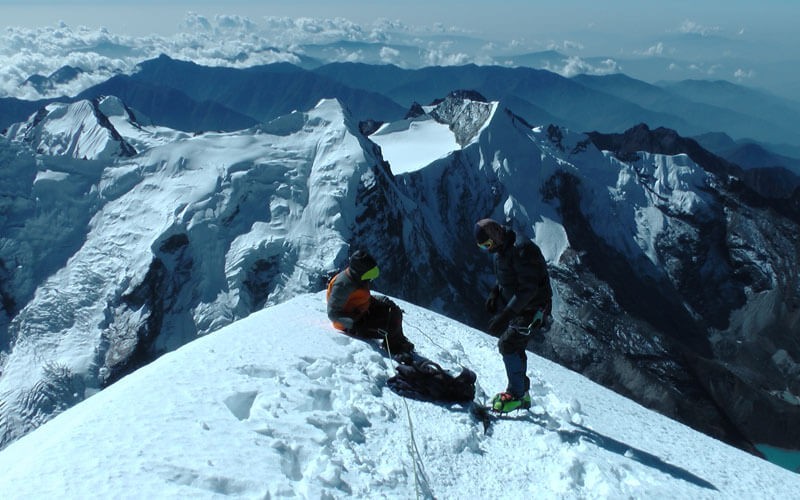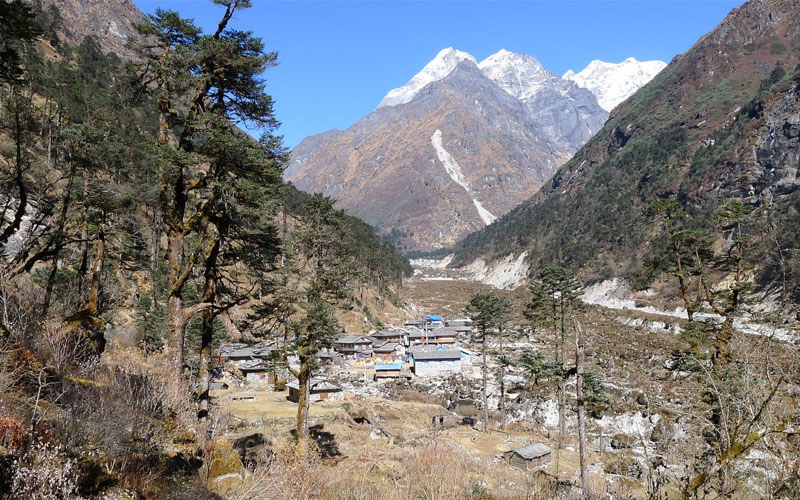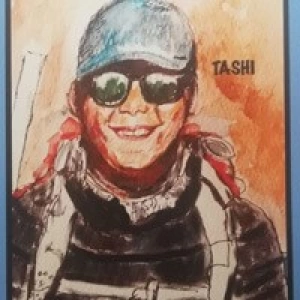
Follow your dream of climbing a mountain in the shadow of Everest.
Five great reasons why you should climb Mera Peak 6476m, which lies just south of Mt. Everest
1. You don’t need to be a mountaineer to climb Mera Peak! Very fit trekkers with a sense of adventure can make this their first climbing expedition. The required technical skills can be learned at base of the Mera Glacier. Our expert climbing Sherpa will make sure first time climbers are confident with skills such as ascending and descending on fixed ropes using jumars and abseil/ rappel devices, which are needed for the steep final section near the summit of Mera Peak.
2. The view from Mera Peak is widely proclaimed to be the finest in the Everest Region. From High Camp and above is no doubt one of the most impressive Himalayas vistas which includes of five 8000-meter peaks: Mount Everest, 8848m, Lhotse, 8516m, Cho Oyu,8201m, Makalu, 8463m, and Kangchenjunga, 8586m.
3. You will be trekking through the beloved homeland of your Sherpa team. Annapurna Foothills Treks’ entire staff comes from the Sherpa tribe native to Solukhumbu. It will add another dimension to your trip to visit your Sherpa’s native villages, meet their relatives and friends, learn about their culture, and eat their food.
4. The path to Mera Base Camp is a wonderful trek through forests of Rhododendron, oak, silver fir, birch, and beautiful alpine lakes of the sparsely inhabited Hongu Valley.
5. Mera La pass, 5415m, joins the remote Hongu valley with the more remote Hinku valley. Base Camp is just below the pass on the Hongu Valley side.
Mera Peak Facts:
- Though classified as a trekking peak, the standard north route of Mera could technically be called a straightforward expedition. Although the snow slopes rarely exceed 40 degrees the altitude makes it a tough enough challenge, much harder than the strenuous high-pass treks. Even walking at extreme altitudes is always really hard work.
- The greatest risk may be the fact that the Mera Peak can be reached quickly, before you are properly acclimatized to the altitude. Weather and snow conditions can make it more complicated.
- It is essential that you come prepared with clothes and equipment to cope with the low temperatures. The wind chill factor on summit day can get down to -35 Degrees Celsius
- Mera has three distinct summits: Mera North, 6476m, Mera Central, 6461m, and Mera South, 6065m. Most trekkers climb Mera Central although the highest one Mera North is just a stone’s throw away. Though the route to Mera Central is actually steeper, the slopes are less likely to avalanche making Mera Central objectively safer for less experienced climbers who are less familiar with skills such as ice axe arrest.
- Under favorable conditions, it is possible to climb the peak and descend back on the same day.
Mera Peak Climbing Approaches:
There four possible routes to Mera Peak Base Camp; three begin with a flight to Lukla, 2800m, the other starts after a bus ride to Jiri.
1. The shortest option, 13-days, follows the most direct route to Mera Peak, a great option for a strong trekker or novice mountaineer with limited time. It goes over the steep Zatra La pass, 4600m, on the second day of the trek. Besides the big altitude gain the pass can be covered with snow and ice on the Lukla side. This is a teahouse trek with camping only during the climb.
2. The 20-days route avoids the steep climb to Zatrwa La pass by looping south from Lukla into a beautiful untraveled part of the country and joining the main trail at Kote. This package is a teahouse trek with camping only during the climb.
3. The 23-days option also loops south from Lukla and crosses the Surke La pass into the remote and beautiful Hinku valley. The trail passes through Pangom village and the holy Panch Pokhari (Five Lakes). This fantastic trek involves long days of ascents and descents allows for gradual acclimatization. This trek through an almost uninhabited area is not only the best way to acclimatize; it is the ultimate way to enjoy the beauty of the Hongu Valley.
4. Another option to consider, for those with time, is starting from Jiri. It takes an 11 hr bus ride on a bumpy, windy road to reach the trailhead at Jiri.The steep, narrow paths lead through forests, mountains and valleys, and Sherpa villages where few tourists have ventured.This option will assure you of maximum acclimatization and at the same time, give you incredible insight into life in the remote parts of Nepal.
All approaches converge to follow the same trail above Kote. At Thangnak, 4356m, and Khare, 5045m, we spend two nights to acclimatize. We use the acclimatization days learning and practicing mountaineering techniques.

We ascend a ridge above Khare to access the glacier. Once onto the glacier it is a flat walk to Mera La, 5300m, and then a quick descent to Base Camp on east side of this pass.
On the next day we head up the glacier to High Camp, 5800m. Once we reach high camp we enjoy a panoramic view from Makalu and Kanchenjunga to the east, Everest and Lhotse to the north and Cho Oyu to the northwest.
On summit day we have to start out around 2am in order to reach the summit by mid morning. It is windy, cold and dark and the best way of staying warm is to keep moving, winding around the crevasses to reach the Col below the summit. After enjoying the views from the top it is a quick descent to High Camp where we pause for hot refreshments before continuing down to Khare by 2pm or 3pm.
The return Trek: All expeditions return to Lukla via the Hongu valley and over the Zatra La pass. It takes three days to return to Lukla and the Zatra La pass is crossed on the third day. The descent on Lukla side is steep and can be icy so if need by your Sherpa will go ahead to fix some rope to safeguard the descent.
Annapurna Foothills Treks and Expedition takes pride in well organized trips by paying attention to every detail. Your team will be enthusiastic and tireless in day to day management. We do everything reasonably possible to make your summit not only a reality, but a fun adventure.
Plan your trip at least 2 months ahead of time. This is the best way for you to be prepared and for us to have time to organize the details that make the difference between simply a summit, and an amazing expedition. For example, flight bookings are difficult to come by in peak season. Early booking assures an earlier morning flight, which increases the chances of you starting your trip on time. The later the flight, the higher the chances that it could be cancelled due to weather disturbances.
The history: Col. Jimmy Roberts and Sen Tenzin first ascended Mera Central in 1953, tracing a route that is still the standard route. Mera North was not climbed until much later, when a French team reached the summit in 1975.

